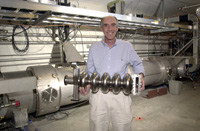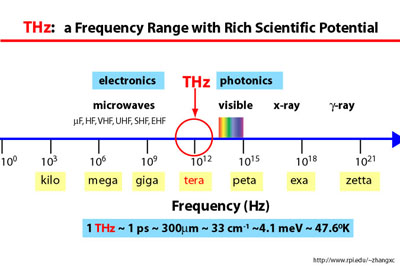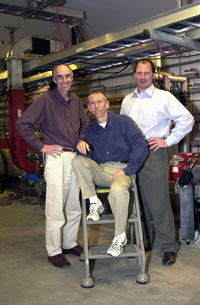
Gwyn Williams, JLab's FEL Basic Research Program manager, led a multi-lab experiment that generated nearly 20 watts of terahertz radiation - a world record.
An experiment conducted by the Department of Energy's Jefferson Lab generates THz radiation 20,000 times brighter than anyone else; breakthrough lights way for application development
An experiment conducted with Jefferson Lab's Free-Electron Laser (FEL) has shown how to make a highly useful form of light - called terahertz radiation - 20,000 times brighter than ever before. Jefferson Lab is a Department of Energy laboratory located in Newport News, Virginia.
The name "terahertz radiation" derives from the frequency of the radiation - of the order of one trillion oscillations per second. The corresponding wavelength is of the order of tenths of a millimeter. Terahertz radiation is thus located in the spectrum of electromagnetic radiation between the upper end of the microwave range (mm wavelength) and the far infrared (hundredths of mm). Terahertz radiation is non-ionizing and shares with microwaves the capability to penetrate a wide variety of non-conducting materials.
Gwyn Williams, JLab's Free-Electron Laser Basic Research Program manager, conceived and led the multi-laboratory team conducting the experiment, which took place during November 2001. The results were published in the Nov. 14, 2002, issue of the international science journal Nature.
Among the prospective benefits, the breakthrough lights the way toward better detection of concealed weapons, hidden explosives and land mines; improved medical imaging and more productive study of cell dynamics and genes; real-time "fingerprinting" of chemical and biological terror materials in envelopes, packages or air; better characterization of semiconductors; and widening the frequency bands available for wireless communication.
To produce, for the first time ever, intense terahertz radiation, researchers from JLab and two other Department of Energy laboratories — Brookhaven National Lab and Lawrence Berkeley National Lab — made use of the fact that the driver linac of JLab's Free-Electron Laser is made up of intense electron bunches that are a few tenths of a millimeter long, i.e. comparable to the wavelength of terahertz radiation. Sending any energetic electron beam through a magnetic field makes the beam emit radiation, so-called synchrotron radiation, a process that is greatly enhanced (coherent synchrotron radiation) when the length of the electron bunches is as short or shorter than the radiation wavelength of interest.

Terahertz radiation has much scientific potential.
Researchers paving way for T-ray applications
For over a decade, scientists worldwide have been pressing the study of light in the terahertz region and looking for better ways to generate and use it. The light is also referred to occasionally as T-rays, T-light or T-lux. An August 16 Science magazine article, "Revealing the Invisible," reported that "much research is being directed toward the development of T-ray sources and detectors, particularly for applications in medical imaging and security scanning systems." Xi-Cheng Zhang, a T-ray expert at Rensselaer Polytechnic Institute, predicts that terahertz light will be "the future 'killer application' ... in biomedicine."
Picometrix Tochigi Nikon Corporation and Teraview — a Cambridge, England, start-up associated with Toshiba — have begun commercializing low-power terahertz systems. A few hospitals are already testing comparatively dim sources of terahertz light for detecting skin cancer.
Overall, though, terahertz light still constitutes a gap in the science of light and energy. It inhabits a region of the electromagnetic spectrum not that well understood. Now that a way to generate it at high power has been demonstrated, terahertz light can potentially extend and add widely to the wave-based technologies that have defined the last 150 years: from the telegraph, radio and X-rays to computers, and cell phones.
Up to this point, no other method of generating terahertz waves had yielded more than two-thousandths of a watt in power. But Williams and his colleagues extracted nearly 20 watts — some 20,000 times more. "Think of a candle and then think of a floodlight," says Williams.

Left to right: Gwyn Williams and his two JLab co-authors for the Nature paper — George Neil and Kevin Jordan — stop for a quick photo in the FEL vault.
But no matter how bright they are, terahertz light rays can't penetrate metal or water. So they can't be used to inspect cargo containers on arriving ships or to diagnose conditions deep inside the human body. "Nevertheless," says Williams, "the growing awareness of terahertz light's usefulness is like what happened a century ago with X-rays — only terahertz light will have a much wider range of applications. The task now will be to develop those uses."
Bringing 10-year-old idea to fruition
About 10 years ago Williams wrote a paper proposing a method for generating large amounts of terahertz light. In the mid-90s he started following the development of JLab's Free-Electron Laser. Williams came to Jefferson Lab from Brookhaven National Lab in the spring of 2000; he actively began pursuing his experiment last June, when he drove a van to Brookhaven to bring back a spectrometer on loan from his old laboratory. Kevin Jordan and George Neil, both JLab staff, soon had it installed and proof-of-principle experiments took place. The final run, with a better spectrometer and detector, took place in early November 2001 and included Larry Carr from Brookhaven, and Michael Martin and Wayne McKinney from Lawrence Berkeley National Lab.
"We didn't create something new," Williams explains. "The terahertz light had always been there inside of the FEL's vacuum-sealed beam pipe. We just figured out how to open the pipe, put in a window to let the light out, and how to measure it." Williams is looking forward to performing proof-of-principle experiments of the capabilities of THz light with the upgraded FEL and a newly designed section of FEL beam pipe that should allow even more of the light out.
Williams and his collaborators presented their results at the First International Conference on Terahertz Radiation in December of 2001, and shortly thereafter he wrote the experiment up and submitted it to Nature. Due to the novel arena, it took some time before the paper was accepted, but it finally was.
While the U.S. Navy funded the FEL's construction to investigate the science and technology of high-power laser beams whose precise wavelength can be selected, the funding to run Williams' and his colleagues' experiment was from the Commonwealth of Virginia.

